1909 Indian Head Penny Coin Value: How Much Is It Worth?
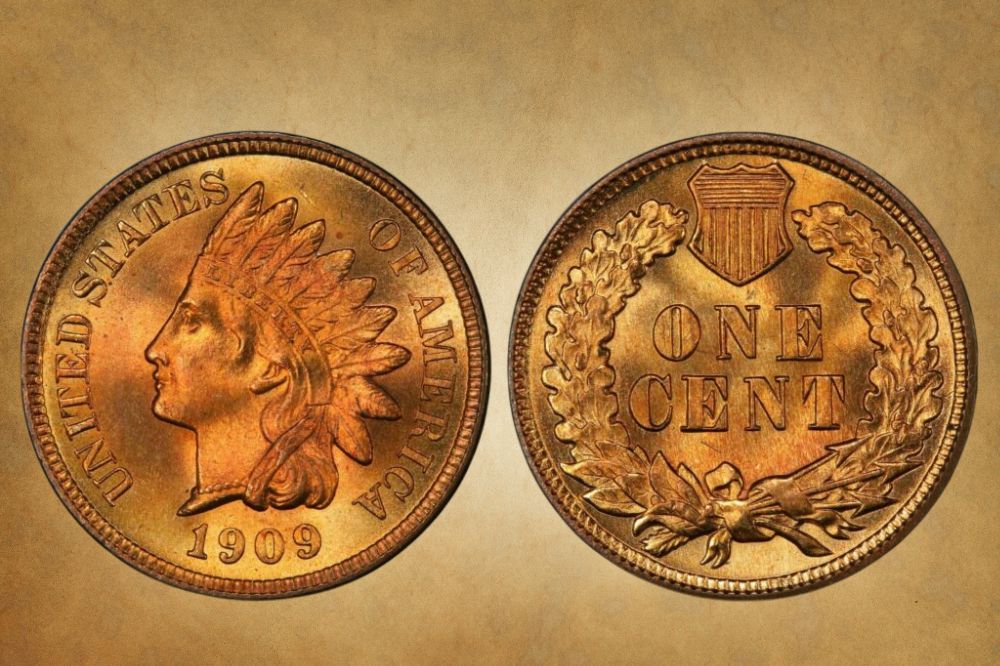
The Indian Head penny was the first attempt to honor American Natives. However, the designer instead depicted Lady Liberty with a headdress as the central figure.
The US Mint struck these coins from 1859 to 1909, making those minted in 1909 the last in the series. The 1909 Indian Head penny value can be modest or pretty high, depending on the grade and surface coloring.
1909 Indian Head penny Value |
||
| Condition | 1909 No Mint mark penny | 1909 S penny |
| Good | $13 | $607 |
| Very good | $17 | $658 |
| Fine | $19 | $752 |
| Very fine | $23 | $816 |
| Extra fine | $28 | $940 |
| AU | $34 | $1,028 |
| MS 60 | $51 | $1,134 |
| MS 63 | $74 | $1,318 |
| PR 63 | $160 | / |
The Value Guides of the 1909 Indian Head Penny
The Indian Head penny mintage was 14,679,645 coins in 1909, far less than in previous years. The probable reason was the fact that it was the last year of these pennies’ production before the US Mint replaced them with Lincoln cents.
1909 No Mint Mark Indian Head penny Value
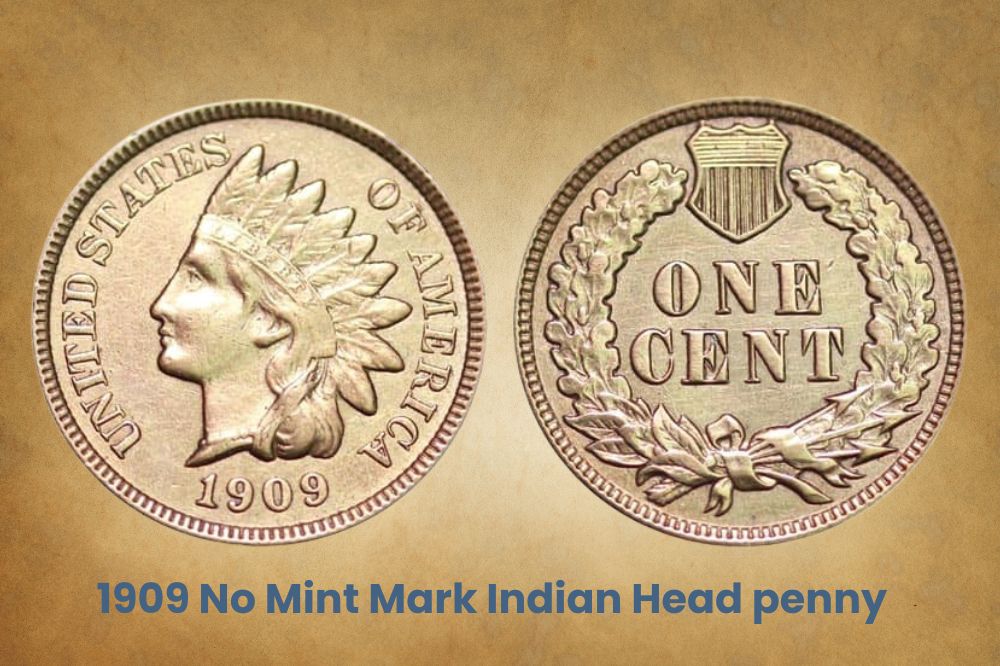
The value of the 1909 Indian Head pennies minted in Philadelphia depends on their toning and preservation levels. This mint produced 14,368,470 coins from regular strikes, and you can buy brown-colored pieces that spent years in use for $4 to $35.
1909 No Mint mark Indian Head penny prices |
|||
| Condition | 1909 BN penny | 1909 RB penny | 1909 RD penny |
| Good | $4 to $6 | / | / |
| Very good | $6 to $7.20 | / | / |
| Fine | $7 to $9.60 | / | / |
| Very fine | $9 to $14.40 | / | / |
| Extra fine | $15 to $24 | / | / |
| AU | $24 to $33.75 | / | / |
| MS 60 | $32 to $40 | / | / |
| MS 61 | $36 to $45 | $50 to $62.50 | $80 to $100 |
| MS 62 | $46 to $57.50 | $62 to $77.50 | $105 to $131.25 |
| MS 63 | $62 to $77.50 | $80 to $100 | $130 to $162.50 |
| MS 64 | $80 to $100 | $140 to $175 | $240 to $300 |
| MS 65 | $125 to $156.25 | $225 to $281.25 | $500 to $600 |
| MS 66 | $275 to $343.75 | $380 to $475 | $1,100 to $1,400 |
| MS 67 | $1,350 to $1,700 | $1,600 to $2,150 | $3,100 to $7,250 |
Some uncirculated brown coins are affordable and cost about $30 to $345. However, the best-quality pieces in an MS 67 grade can reach $1,350 to $1,700 during good auction days.
On the other hand, pennies with collectible red toning quickly reach $1,100 to $7,250 at auctions, depending on the rating. One of these coins won the auction record after selling for $21,600 in 2023.
1909 proof Indian Head penny Value
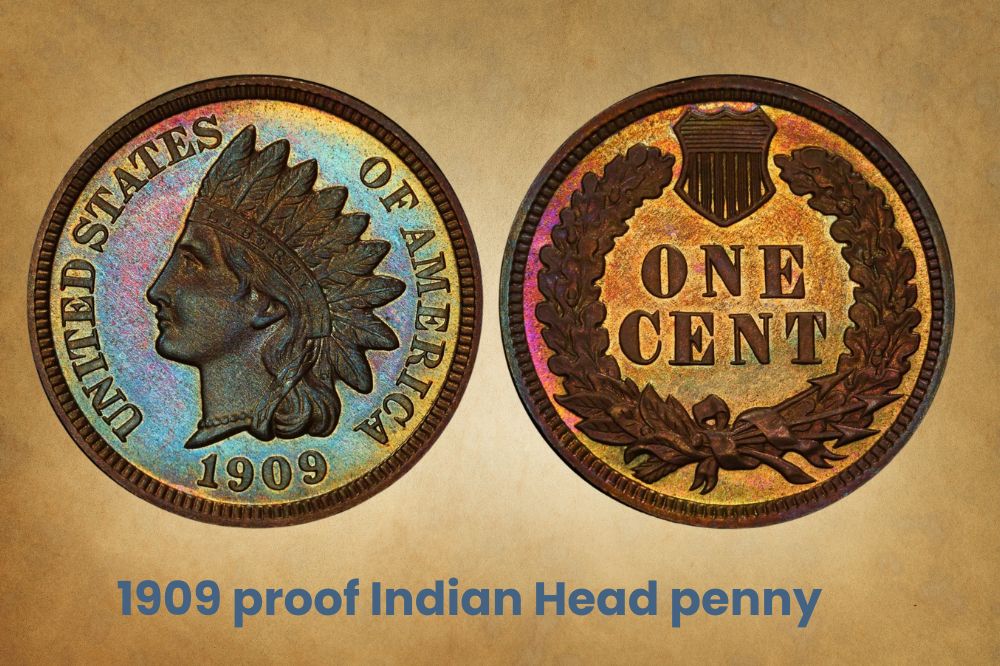
The 1909 Indian Head proof penny value is approximately $110 to $4,800, depending on their look and color. As expected, red specimens are the most collectible, but they make up the smallest part of the 2,175 produced coins.
1909 proof Indian Head penny Value |
|||
| Condition | 1909 PR BN penny | 1909 PR RB penny | 1909 PR RD penny |
| PR 60 | $110 to $132 | $135 to $162 | $200 to $240 |
| PR 61 | $125 to $150 | $170 to $204 | $225 to $270 |
| PR 62 | $145 to $174 | $200 to $240 | $250 to $300 |
| PR 63 | $170 to $204 | $2306 to $276 | $280 to $336 |
| PR 64 | $230 to $276 | $335 to $402 | $460 to $552 |
| PR 65 | $335 to $402 | $450 to $540 | $925 to $1,110 |
| PR 66 | $ 700to $880 | $1,025 to $1,230 | $1,400 to $1,680 |
| PR 67 | $1,650 to $1,980 | $2,000 to $2,400 | $4,000 to $4,800 |
Two proof pennies won the highest prices at auctions. One red coin with a PR 66 rating reached $18,975 in 2005, while the one with desirable cameo contrast was paid $18,000 in 2019.
1909 S Indian Head penny Value
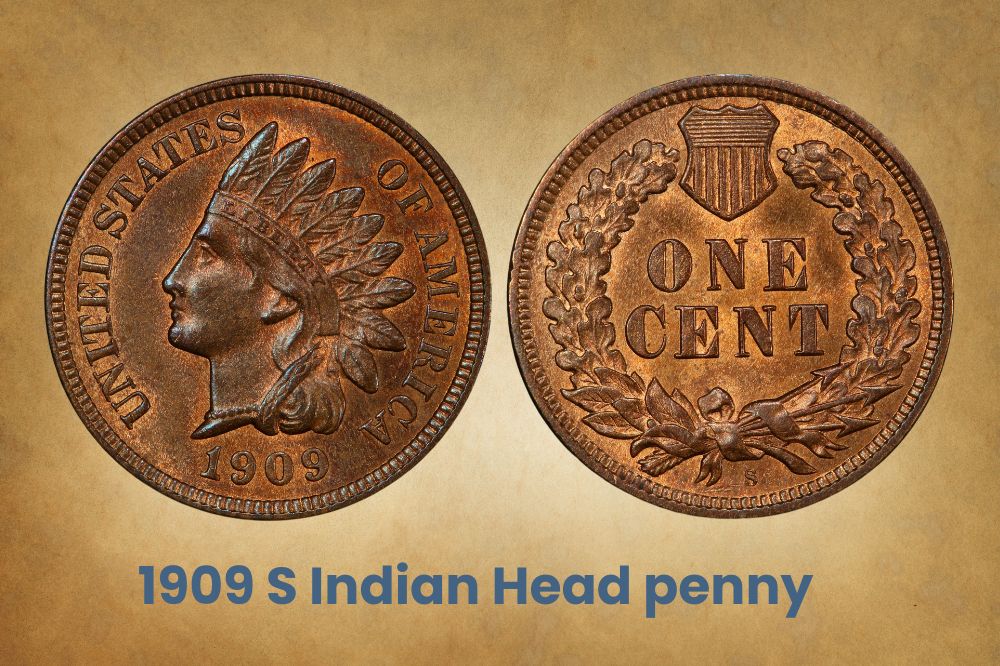
Indian Head pennies from San Francisco are valuable, primarily thanks to the low mintage of 309,000. As you can guess, their prices are higher than pieces that come from Philadelphia, and you need to set aside $235 to $2,375 for one coin with brown toning.
1909 S Indian Head penny Value |
|||
| Condition | 1909 S BN penny | 1909 S RB penny | 1909 S RD penny |
| Good | $235 to $288 | / | / |
| Very good | $250 to $312 | / | / |
| Fine | $315 to $390 | / | / |
| Very fine | $360 to $510 | / | / |
| Extra fine | $500 to $660 | / | / |
| AU | $600 to $1,063 | / | / |
| MS 60 | $860 to $1,075 | / | / |
| MS 61 | $875 to $1,094 | $1,000 to $1,250 | / |
| MS 62 | $1,000 to $1,250 | $1,050 to $1,313 | $1,200 to $1,500 |
| MS 63 | $1,150 to $1,438 | $1,400 to $1,750 | $1,400 to $1,750 |
| MS 64 | $1,400 to $1,750 | $1,900 to $2,375 | $1,900 to $2,375 |
| MS 65 | $1,900 to $2,375 | $2,500 to $3,125 | $4,250 to $5,313 |
| MS 66 | / | $4,200 to $5,250 | $9,000 to $11,250 |
| MS 67 | / | / | $45,000 to $60,000 |
Red-brown pennies are more costly and are typically worth $1,000 to $5,250. The most collectible is those with the lovely red surface color. Only the best-rated pieces have such a feature, and their prices go from $1,200 to $60,000.
One red Indian penny with the S mint mark and an MS 67 grade is the most expensive in the set. One collector paid $97,750 for it at Heritage Auctions in 2006.
Related Posts: 16 Most Valuable Wheat Penny Errors
1909 Indian Head Penny Errors
Interestingly, it is practically impossible to find error coins among the 1909 Indian Head pennies. Despite pieces with minor imperfections, this year is not known for unique pennies besides those from the regular issue.
Related Posts: 19 Most Valuable Lincoln Memorial Penny Worth Money
History of the 1909 Indian Head Penny
Pennies are one-cent coins equal to one-hundredth of a dollar. They have the lowest face value since the cancellation of the half-cent in 1857.
The first penny (Franklin cent, Fugio cent) appeared in 1787, representing the first American official circulation coinage. Besides, you can find numerous penny types minted in two sizes:
Large cents
- Flowing Hair penny with a chain on the reverse, minted in 1793
- Flowing Hair penny with a wreath on the reverse, minted in 1793
- Liberty Cap penny, minted from 1793 to 1796
- Draped Bust penny, minted from 1796 to 1807
- Classic Head penny, minted from 1808 to 1814
- Coronet penny, minted from 1816 to 1839
- Braided Hair penny, minted from 1839 to 1857 and in 1868 as an irregular issue
Small cents
- Flying Eagle penny, minted from 1856 to 1858
- Indian Head penny, minted from 1859 to 1909
- Lincoln (Wheat) penny, minted from 1909 to 1958
- Lincoln (Memorial) penny, minted from 1959 to 2008
- Lincoln Bicentennial penny with four reverse designs, minted in 2009
- Lincoln (Union Shield) penny, minted from 2010 to the present
Besides design, the penny composition also varied over time. You can distinguish a few penny types based on the metal used for their production:
- From 1793 to 1795, pennies weighing 0.47549 ounces (13.48 g) contained 100% copper
- From 1795 to 1857, pennies weighing 0.38413 ounces (10.89 g) contained 100% copper
- From 1856 to 1864, pennies weighing 0.16473 ounces (4.67 g) contained 88% copper with added nickel
- From 1864 to 1942, pennies weighing 0.10970 ounces (3.11 g) contained 95% copper with added zinc or tin (bronze)
- In 1943, pennies weighing 0.09595 ounces (2.72 g) contained zinc-coated steel
- From 1944 to 1946, pennies weighing 0.10970 ounces (3.11 g) contained 95% copper with added zinc (gilding metal)
- From 1947 to 1962, pennies weighing 0.10970 ounces (3.11 g) contained 95% copper with added zinc or tin (bronze)
- From 1962 to 1982, pennies weighing 0.10970 ounces (3.11 g) contained 95% copper with added zinc (gilding metal)
- From 1982 to the present, pennies weighing 0.08819 ounces (2.5 g) contained copper-plated zinc (97.5% with added copper)
1909 Indian Head penny |
||
| Location | Year | Minted |
| Philadelphia | 1909 No Mint mark penny | 14,368,470 |
| Philadelphia | 1909 proof penny | 2,175 |
| San Francisco | 1909 S penny | 309,000 |
| Total | / | 14,679,645 |
Pennies practically have no purchasing power in the modern world because of inflation. Besides, they have become too expensive to mint since the 2010s because of raised prices of copper used for their production.
The US Mint is in the unenviable situation of paying two pennies to make a coin worth twice less. Therefore, officials look for alternative metals convenient for minting these historical coins. Unfortunately, their elimination from circulation is also one of the possibilities.
Related Posts: 19 Most Valuable Wheat Penny Worth Money
How to Identify the 1909 Indian Head Penny?
Indian Head pennies are collectible American coinage, and most collectors enjoy forming the series by dates, mint marks, or types. Despite showing a Caucasian Lady Liberty, the idea was to give a tribute to Native Americans by adding a headdress on her head.
It was an ironic decision since the coin occurred in circulation in a period when Indians were relocated to reservations after losing their ancestral lands.
The 1909 Indian Head penny obverse
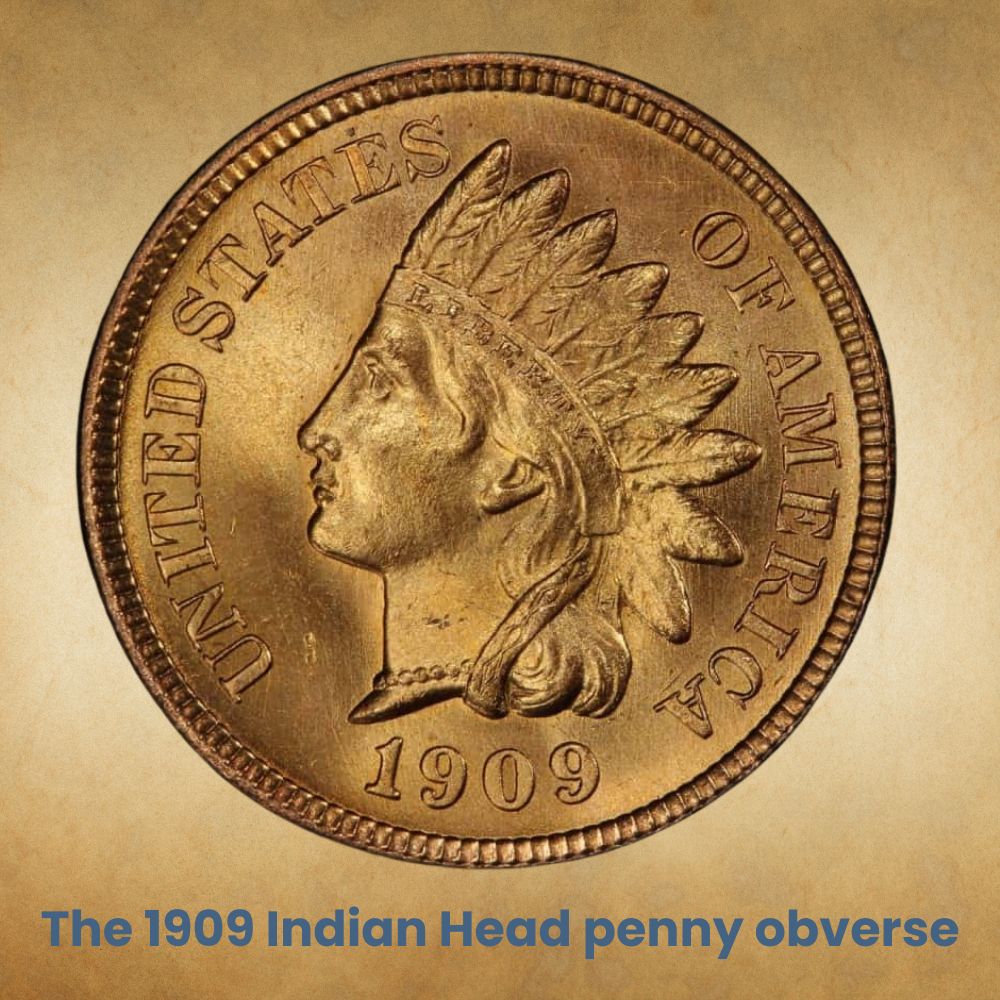
Engraver James Barton Longacre depicted Lady Liberty on the 1909 Indian Head penny obverse, although the idea was for the central position to be occupied by an American native.
She is facing left and wears a headdress with the inscription LIBERTY. The UNITED*STATES*OF*AMERICA and the DATE placed along the coin rim surround it. You can also spot the letter L above the first curl, representing the designer’s initial.
The 1909 Indian Head penny reverse
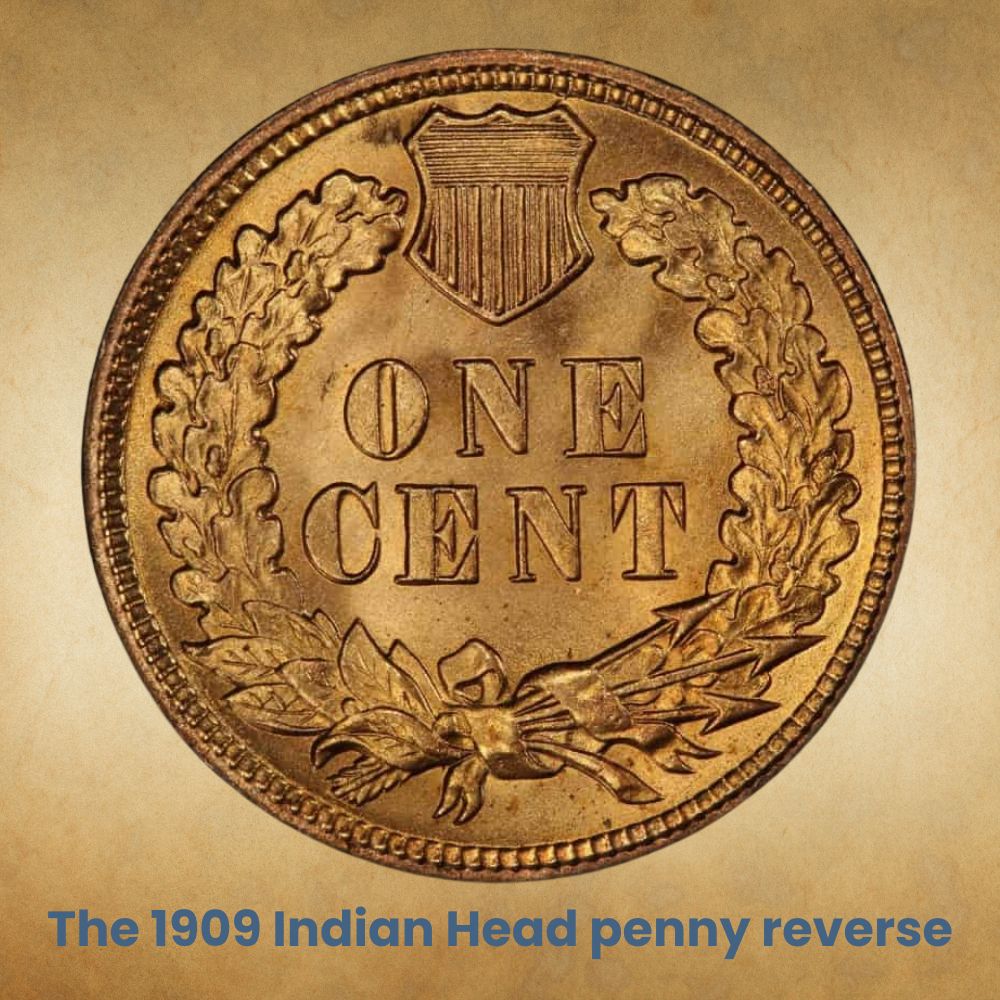
This coin’s reverse appearance is simple but effective, with two oak branches surrounding the ONE*CENT denomination in the center.
A wreath and three arrows are tied by a ribbon at the bottom, while a shield with 13 stripes is placed on the top. These horizontal and vertical lines symbolized the first States that formed the US.
1909 Indian Head penny |
|
| Shape | Round |
| Coin weight | 0.11 ounces (3.11 grams) |
| Compound | An alloy of 95% copper (the rest is zinc or tin) |
| Face value | 1 cent ($0.01) |
| Edge | Plain |
| Coin thickness | 0.039 inches (1 millimeter) |
| Coin diameter | 1.75 inches (19 millimeters) |
Other features of the 1909 Indian Head penny
The 1909 Indian Head penny is a lovely one-cent American coin made of 95% copper. Its thickness is 0.039 inches (1 millimeter), and its diameter is 1.75 inches (19 millimeters), typical values for this coin type. Its precise weight is 0.11 ounces (3.11 grams), and the edge is plain.
What makes 1909 Indian Head pennies rare?
Collectors consider all 1909 Indian Head pennies produced in San Francisco rare and valuable. In most cases, only those with the highest budgets can afford one of these coins with the best rating. Even if you are willing to pay thousands of dollars for one of these pennies, it is likely to be challenging to find it on the market.
Which 1909 Indian Head pennies are worth a lot of money?
- 1909 S MS 67 red Indian penny ($97,750 at Heritage Auctions, 2006)
- 1909 MS 67+ red Indian penny ($21,600 at Heritage Auctions, 2023)
- 1909 PR 66 red Indian penny ($18,975 at Heritage Auctions, 2005)
- 1909 PR 66+ Indian penny with cameo contrast ($18,000 at Stack’s Bowers, 2019)
- 1909 MS 67 RB Indian penny ($8,700 at Stack’s Bowers, 2020)
- 1909 S MS 66+ red-brown Indian penny ($7,638 at Legend RCA, 2019)
- 1909 PR 67 red-brown Indian penny ($3,738 at Heritage Auctions, 2006)
- 1909 S Genuine brown Indian penny ($3,400 on eBay, 2021)
- 1909 PR 66 brown Indian penny ($1,560 • 08-19-2018 • Heritage Auctions, 2018)
- 1909 MS 65 red DDO Indian penny ($1,000 on eBay, 2022)
- 1909 MS 64 red-brown DDO Indian penny ($660 at Heritage Auctions, 2021)
- 1909 MS 63 brown Indian penny ($500 on eBay, 2021)
- 1909 MS 64 brown DDO Indian penny ($432 at Heritage Auctions, 2021)
How much do the 1909 No Mint mark Indian Head pennies cost?
The least expensive 1909 Indian Head pennies without the mark are brown ones in low grades that cost $4 to $35. The estimated value for the best-preserved brown pieces is $1,350 to $1,700, while top-quality red ones can be worth $1,100 to $7,250.
